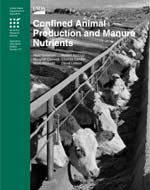Confined Animal Production and Manure Nutrients
- by Noel Gollehon, Margriet Caswell, Marc Ribaudo, Robert Kellogg, Charles Lander and David Letson
- 6/15/2001
Overview
Census of agriculture data were used to estimate manure nutrient production and the capacity of cropland and pastureland to assimilate nutrients. Most farms (78 percent for nitrogen and 69 percent for phosphorus) have adequate land on which it is physically feasible to apply the manure produced onfarm at agronomic rates. (The costs of applying manure at these rates have not been assessed). Even so, manure that is produced on operations that cannot fully apply it to their own land at agronomic rates accounts for 60 percent of the Nation's manure nitrogen and 70 percent of the manure phosphorus. In these cases, most counties with farms that produce ""excess"" nutrients have adequate crop acres not associated with animal operations, but within the county, on which it is feasible to spread the manure at agronomic rates. However, barriers to moving manure to other farms need to be studied. About 20 percent of the Nation's onfarm excess manure nitrogen is produced in counties that have insufficient cropland for its application at agronomic rates (23 percent for phosphorus). For areas without adequate land, alternatives to local land application--such as energy production--will need to be developed.
Download
-
Entire report
Download PDF -
Abstract
Download PDF -
Contents
Download PDF -
Executive Summary
Download PDF -
Introduction
Download PDF -
Nutrient Impacts on Water Quality Gain Public Policy Attention
Download PDF -
Data and Methodology
Download PDF -
Livestock Sector on the Move
Download PDF -
Land?s Capacity To Use Manure Nutrients
Download PDF -
Most Counties Can Absorb Excess Nutrients of Individual Farms
Download PDF -
Conclusions
Download PDF -
References
Download PDF -
Appendix
Download PDF

